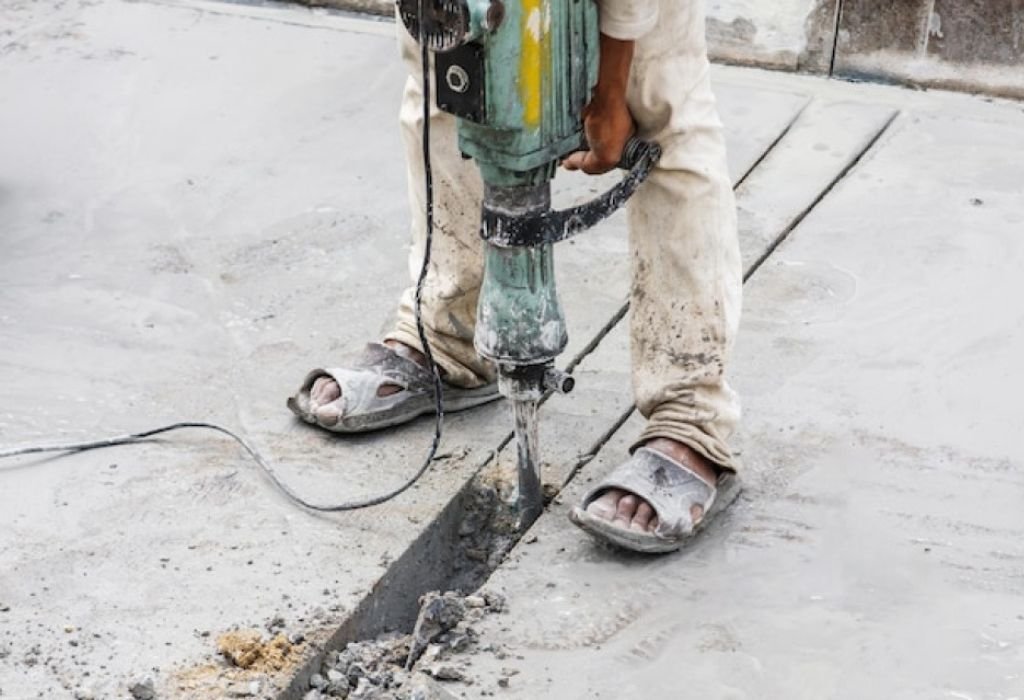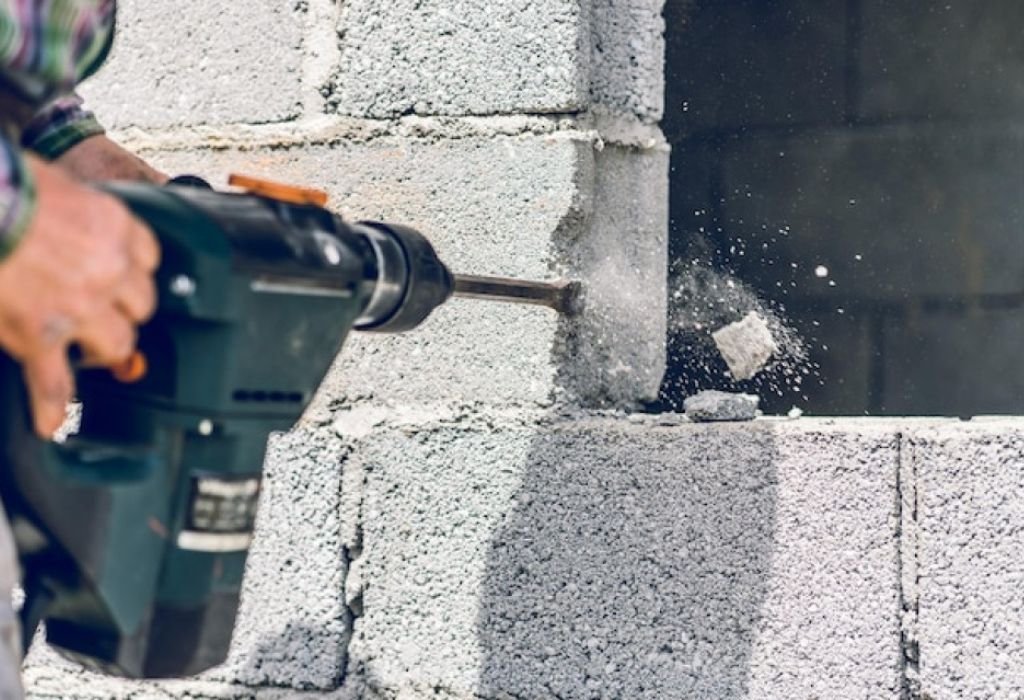You set out to hang shelves on a concrete wall, armed with your impact driver. After a few seconds of drilling, the bit smokes, and progress nearly stops.
This scenario frustrates many DIYers who assume an impact driver can handle any task. While powerful with screws and bolts, its role in drilling concrete is more complicated.
Impact drivers deliver rotational force combined with concussive impacts. This design makes them ideal for driving long screws into wood or metal.
Concrete, however, is much denser and tougher than typical building materials. It requires both drilling power and hammering action to break through effectively.
A hammer drill is usually the best tool for concrete. It combines rotary drilling with direct hammering into the surface, making progress much faster.
That doesn’t mean an impact driver is useless. With the right masonry bits, it may handle shallow holes in softer concrete or brick.
For deeper or frequent drilling, an impact driver struggles. Overheating, worn bits, and wasted time are common outcomes when using it for concrete projects.
According to tool usage surveys, more than 60% of DIYers mistakenly use impact drivers for drilling jobs meant for hammer drills. Knowing the difference saves time and equipment.
This guide answers the question, “can an impact driver drill into concrete,” while explaining its limitations,alternatives, and best practices.
What Is an Impact Driver and How Does It Work?

An impact driver is a cordless power tool that delivers high torque. It combines rotational force with concussive impacts.
This design makes it efficient for driving screws and bolts. Unlike a drill, it doesn’t rely solely on continuous rotation.
Impact drivers use short bursts of power to drive fasteners. This reduces the strain on the user’s wrist.
They are smaller and lighter than hammer drills. This makes them popular for construction and DIY projects.
Impact drivers excel at wood and metal fastening. They are commonly used for decking, framing, and automotive work.
When drilling, they can handle softwoods and sheet metals. However, they are not designed specifically for masonry.
Understanding their purpose helps prevent tool misuse. Knowing limits saves both time and money.
What is an impact driver used for?
Driving screws and bolts into wood and metal.
Is it the same as a drill?
No, it delivers torque with impacts, not continuous rotation.
Why is it popular?
It’s powerful, compact, and reduces wrist strain.
Can it drill concrete easily?
No, it struggles without proper tools.
Can an Impact Driver Drill Into Concrete?
Yes, an impact driver can drill into concrete, but only under specific conditions. It is not the most effective or efficient tool for the job.
With a quality masonry bit, an impact driver can manage shallow holes. This is useful for light-duty anchors or screws.
The tool’s torque helps drive the bit into softer masonry. However, progress slows significantly in dense concrete.
For deep holes or frequent use, an impact driver is impractical. Overheating and bit damage are common issues.
Hammer drills outperform impact drivers in concrete work. Their hammering action is designed for breaking through tough surfaces.
Attempting large projects with an impact driver risks frustration. Time and effort are wasted compared to using the right tool.
Still, for emergency situations, it can be used. Just expect slower results and shorter bit life.
The short answer is yes, but with big limitations.
Can an impact driver drill into concrete?
Yes, but only shallow holes with proper bits.
Is it as good as a hammer drill?
No, hammer drills are much better.
Will it damage the bit?
Yes, bits wear out quickly in concrete.
Should I use it for big projects?
No, it’s best for light-duty drilling only.
Factors That Affect Performance on Concrete
The density of the concrete is the biggest factor. Old, cured concrete is harder than newer pours.
The quality of the drill bit matters just as much. Only masonry bits with carbide tips are suitable.
The power of the impact driver also makes a difference. Higher-voltage models perform slightly better.
Heat buildup is another limitation. Overheating damages both bits and the driver’s motor.
Depth of the hole affects success. Shallow holes may be possible, but deep ones are not practical.
Environmental conditions can play a role. Drilling in cold concrete is harder than in warmer material.
Battery life also impacts performance. Long drilling sessions drain power quickly.
Together, these factors determine whether the attempt succeeds or fails.
Does concrete hardness matter?
Yes, older concrete is much tougher.
Do I need special bits?
Yes, carbide masonry bits are essential.
Will my impact driver overheat?
Yes, during long drilling sessions.
Can it handle deep holes?
No, only shallow holes are realistic.
Best Practices for Using an Impact Driver on Concrete
Always start with a fresh masonry bit. Worn bits make drilling nearly impossible.
Mark the drilling spot clearly before beginning. Accuracy prevents wasted effort.
Use steady, controlled pressure on the driver. Forcing the bit risks snapping it.
Let the tool and bit do the work slowly. Avoid jerky or rushed movements.
Take frequent breaks to cool the bit. Overheating reduces lifespan and effectiveness.
Keep the work area clean of dust. Blowing or vacuuming helps the bit cut more efficiently.
Wear safety glasses and gloves while drilling. Concrete fragments can be sharp and hazardous.
Follow these practices for the best results, even if they’re slower.
Do I need masonry bits?
Yes, standard bits won’t cut concrete.
Should I push hard while drilling?
No, apply steady moderate pressure.
Do I need to cool the bit?
Yes, take breaks to prevent overheating.
Is safety gear necessary?
Yes, protect your eyes and hands.
Why a Hammer Drill Is Better for Concrete

A hammer drill is designed specifically for masonry. It combines rotation with direct hammering action.
This hammering helps break up dense concrete. The bit then cuts through more efficiently.
Hammer drills complete tasks much faster. They reduce strain and extend the life of drill bits.
They can handle both shallow and deep holes. This makes them versatile for construction and DIY.
Hammer drills are available in corded and cordless models. Both outperform impact drivers on concrete.
The cost is often worth the investment. A hammer drill saves time and frustration in the long run.
Professionals always choose hammer drills for masonry. Impact drivers are better reserved for screws and bolts.
When working with concrete, the right tool makes all the difference.
Why is a hammer drill better?
It has a hammering mechanism for masonry.
Does it drill faster?
Yes, much faster than an impact driver.
Can it drill deep holes?
Yes, with less effort and wear.
Is it worth buying one?
Yes, if you work with concrete often.
Alternatives and Tool Upgrades
Rotary hammers are even more powerful than hammer drills. They are ideal for heavy-duty concrete work.
Cordless hammer drills provide flexibility. They combine portability with masonry capability.
Specialty masonry bits improve results with any tool. Using carbide or diamond-tipped bits increases efficiency.
For small jobs, a manual masonry drill bit with a hammer can work. This is labor-intensive but effective.
Some DIYers rent hammer drills for occasional use. This saves money without sacrificing effectiveness.
If you already own an impact driver, consider pairing it with other tools. Use it for screws while reserving masonry drilling for a hammer drill.
Upgrading tools depends on how often you work with concrete. Frequent projects justify buying professional-grade equipment.
Choose the right option for your needs and budget.
What is a rotary hammer?
A heavy-duty tool for masonry.
Can I rent tools instead of buying?
Yes, many hardware stores rent hammer drills.
Do special bits help?
Yes, carbide or diamond bits last longer.
Should I keep both tools?
Yes, they serve different purposes.
Conclusion
An impact driver can drill into concrete, but only under limited conditions. It is not the best tool for the task.
With proper masonry bits, it may handle shallow holes in softer concrete. However, progress is slow, and bits wear out quickly.
A hammer drill or rotary hammer is far more effective. These tools are designed to break through tough masonry with ease.
For anyone asking “can an impact driver drill into concrete,” the answer is yes — but only for small, light-duty jobs. For serious work, use the right tool for the job.

I’m John F. Nicholas, the founder, lead writer, and drill enthusiast behind 101drill.com. With years of hands-on experience in power tools and DIY projects, I created this platform to share practical knowledge, expert tips, and real-world insights to help others master the art of drilling.
